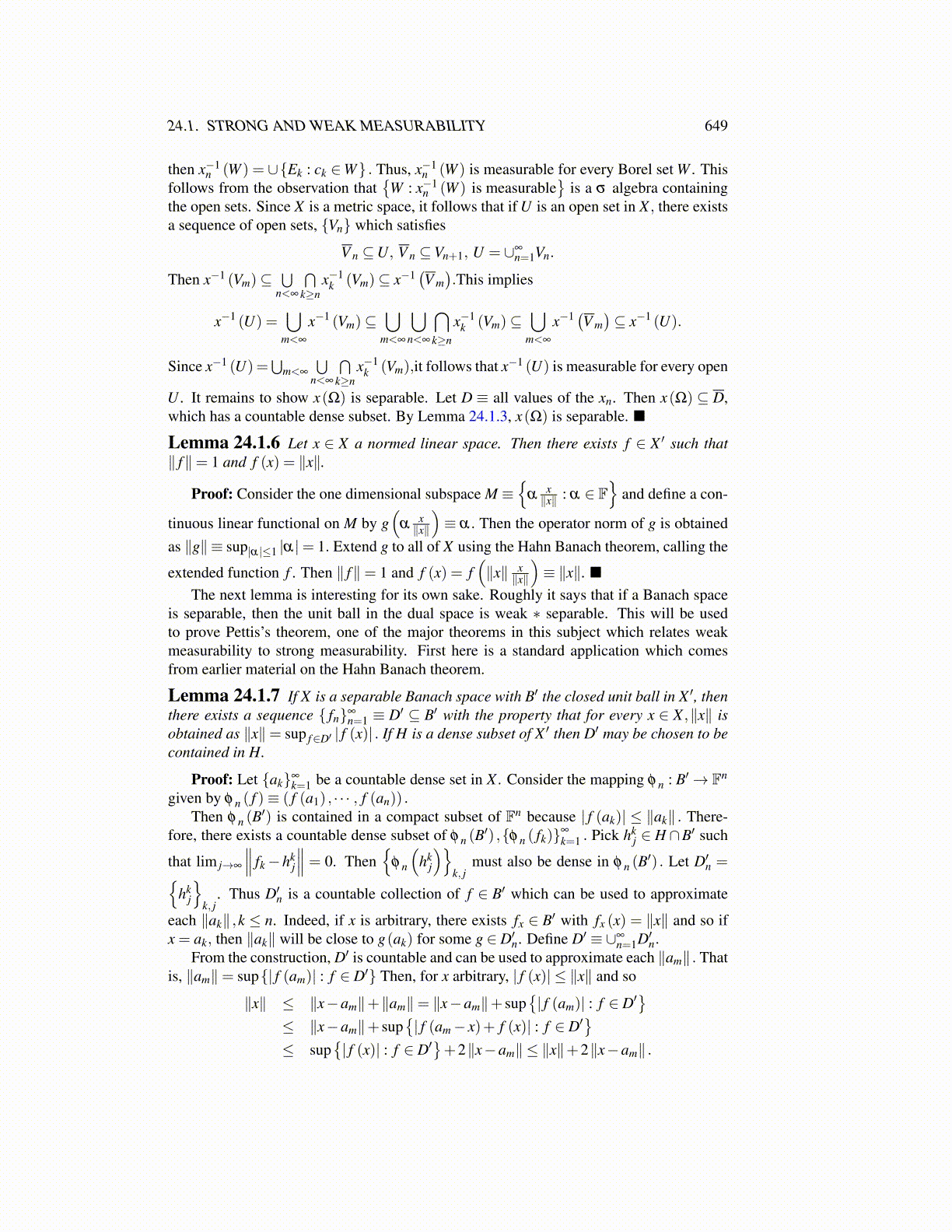
24.1. STRONG AND WEAK MEASURABILITY 649
then x−1n (W ) = ∪{Ek : ck ∈W} . Thus, x−1
n (W ) is measurable for every Borel set W . Thisfollows from the observation that
{W : x−1
n (W ) is measurable}
is a σ algebra containingthe open sets. Since X is a metric space, it follows that if U is an open set in X , there existsa sequence of open sets, {Vn} which satisfies
V n ⊆U, V n ⊆Vn+1, U = ∪∞n=1Vn.
Then x−1 (Vm)⊆⋃
n<∞
⋂k≥n
x−1k (Vm)⊆ x−1
(V m).This implies
x−1 (U) =⋃
m<∞
x−1 (Vm)⊆⋃
m<∞
⋃n<∞
⋂k≥n
x−1k (Vm)⊆
⋃m<∞
x−1 (V m)⊆ x−1 (U).
Since x−1 (U) =⋃
m<∞
⋃n<∞
⋂k≥n
x−1k (Vm),it follows that x−1 (U) is measurable for every open
U . It remains to show x(Ω) is separable. Let D ≡ all values of the xn. Then x(Ω) ⊆ D,which has a countable dense subset. By Lemma 24.1.3, x(Ω) is separable. ■
Lemma 24.1.6 Let x ∈ X a normed linear space. Then there exists f ∈ X ′ such that∥ f∥= 1 and f (x) = ∥x∥.
Proof: Consider the one dimensional subspace M ≡{
αx∥x∥ : α ∈ F
}and define a con-
tinuous linear functional on M by g(
αx∥x∥
)≡ α. Then the operator norm of g is obtained
as ∥g∥ ≡ sup|α|≤1 |α|= 1. Extend g to all of X using the Hahn Banach theorem, calling the
extended function f . Then ∥ f∥= 1 and f (x) = f(∥x∥ x
∥x∥
)≡ ∥x∥. ■
The next lemma is interesting for its own sake. Roughly it says that if a Banach spaceis separable, then the unit ball in the dual space is weak ∗ separable. This will be usedto prove Pettis’s theorem, one of the major theorems in this subject which relates weakmeasurability to strong measurability. First here is a standard application which comesfrom earlier material on the Hahn Banach theorem.
Lemma 24.1.7 If X is a separable Banach space with B′ the closed unit ball in X ′, thenthere exists a sequence { fn}∞
n=1 ≡ D′ ⊆ B′ with the property that for every x ∈ X ,∥x∥ isobtained as ∥x∥= sup f∈D′ | f (x)| . If H is a dense subset of X ′ then D′ may be chosen to becontained in H.
Proof: Let {ak}∞k=1 be a countable dense set in X . Consider the mapping φ n : B′→ Fn
given by φ n ( f )≡ ( f (a1) , · · · , f (an)) .Then φ n (B
′) is contained in a compact subset of Fn because | f (ak)| ≤ ∥ak∥ . There-fore, there exists a countable dense subset of φ n (B
′) ,{φ n ( fk)}∞
k=1 . Pick hkj ∈ H ∩B′ such
that lim j→∞
∥∥∥ fk−hkj
∥∥∥ = 0. Then{
φ n
(hk
j
)}k, j
must also be dense in φ n (B′) . Let D′n ={
hkj
}k, j
. Thus D′n is a countable collection of f ∈ B′ which can be used to approximate
each ∥ak∥ ,k ≤ n. Indeed, if x is arbitrary, there exists fx ∈ B′ with fx (x) = ∥x∥ and so ifx = ak, then ∥ak∥ will be close to g(ak) for some g ∈ D′n. Define D′ ≡ ∪∞
n=1D′n.From the construction, D′ is countable and can be used to approximate each ∥am∥ . That
is, ∥am∥= sup{| f (am)| : f ∈ D′} Then, for x arbitrary, | f (x)| ≤ ∥x∥ and so
∥x∥ ≤ ∥x−am∥+∥am∥= ∥x−am∥+ sup{| f (am)| : f ∈ D′
}≤ ∥x−am∥+ sup
{| f (am− x)+ f (x)| : f ∈ D′
}≤ sup
{| f (x)| : f ∈ D′
}+2∥x−am∥ ≤ ∥x∥+2∥x−am∥ .